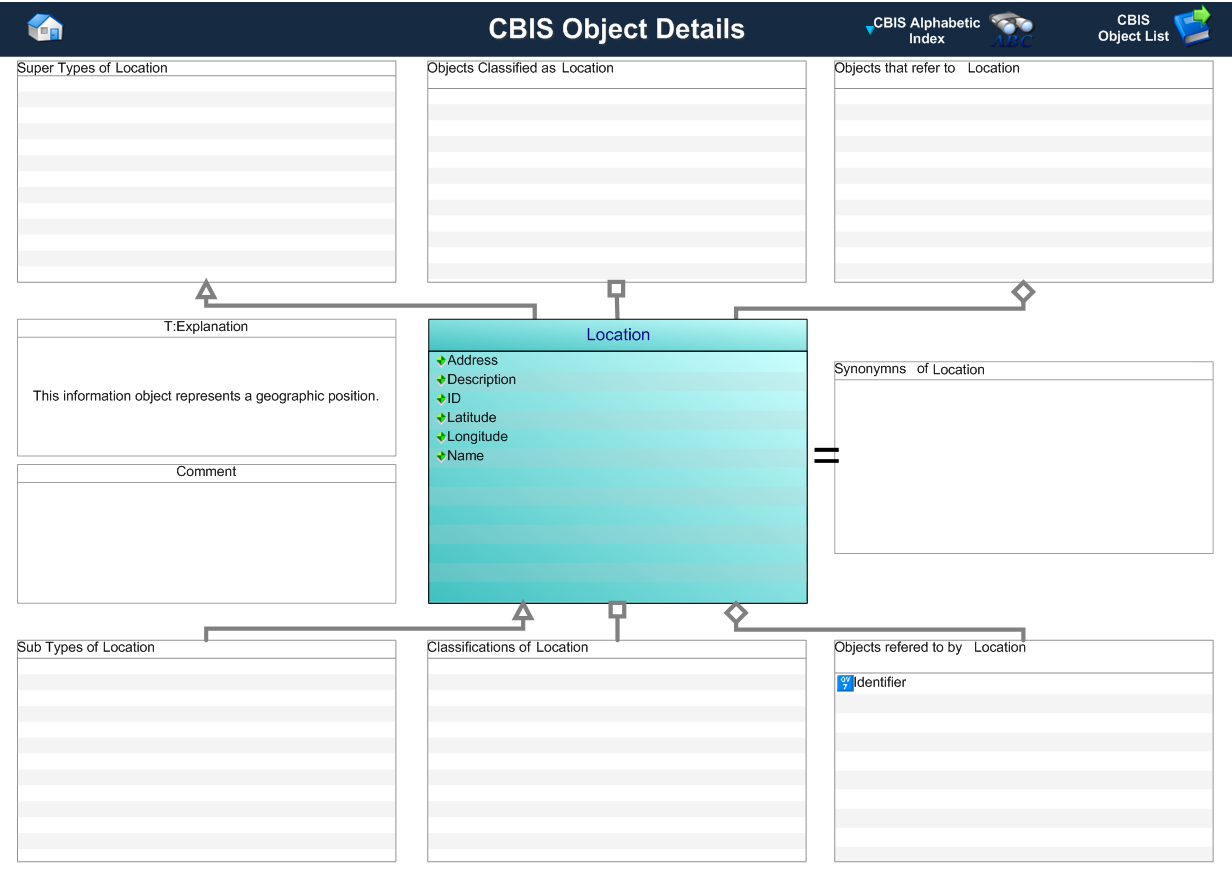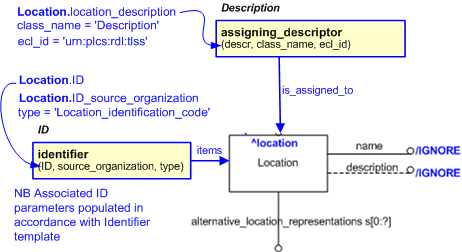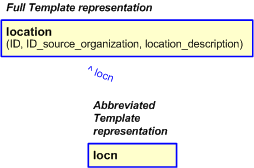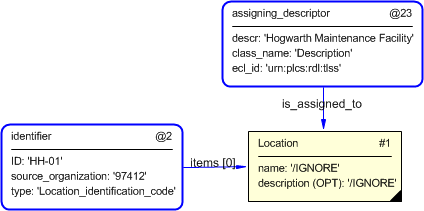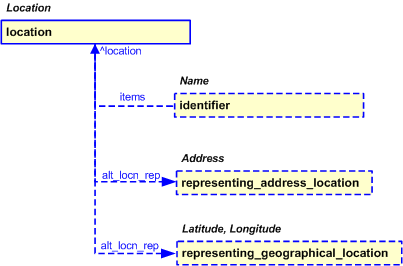Template:— location (locn)
Context:— UK_Defence |
Date: 2009/04/17 10:01:11
Revision: 1.2
|
This section specifies the template location.
NOTE
The template has been defined in the context of
UK_Defence.
Refer to the business context for details of related templates.
NOTE
An explanation of a template and the associated instantiation path is
provided in the
Template overview
section.
This template describes how to represent a location.
Figure 1 — Graphical Representation for Business Object Location
This information object represents the template configuration for a Location.
|
Attribute name
|
Attribute description
|
Attribute type
|
Optionality
|
| ID |
The identity of the location. |
Identifier |
Mandatory |
| Name |
The name of the location. |
Intrinsic |
Optional |
| Description |
The description of the location / environment. |
Intrinsic |
Mandatory |
| Latitude |
The latitude of the location. |
Intrinsic |
Optional |
| Longitude |
The longitude of the location. |
Intrinsic |
Optional |
| ADDRESS |
This is the postal address that may define the location. |
Address |
Optional |
Table 1 — Location attribute details
The optional attributes shown above are described in the characterization section at the bottom and not in the EXPRESS-G like
representation below.
The EXPRESS-G diagram in
Figure
2
shows the templates and EXPRESS entities that are required
to represent the template
"location".
The text highlighted in blue shows the template parameters.
Figure 2 — An EXPRESS-G representation of the Information model for location
The graphic for the template to be used in other EXPRESS-G diagrams
is shown in Figure
3
below.
Figure 3 — The graphical representation of the location template
The following input parameters are defined for this template:
The identifier for the location.
The org code for the org providing/owning the location_id
The description of the location.
The alternative location representations which may be related to the location. It may be used together with this template
by using the reference parameter ^location and its attribute alt_locn_rep: ^location.alt_locn_rep
The following reference parameters are defined for this template:
Allow the
Location
entity instantiated in this path to be referenced when this template is used.
Note: The
Location
entity can be referenced in a template path by:
%^target = $location.location%
where
target
is the parameter to which the
Location
is bound.
The instantiation path shown below specifies the entities that are to be
instantiated by the template.
A description of templates and the syntax for the instantiation path is
provided in the
Templates Help/Information section.
The following entities are instantiated with attributes as specified:
The instance diagram in Figure
4
shows an example of the EXPRESS entities and templates that are instantiated by the template:
/location(ID='HH-01', ID_source_organization='97412', location_description='Hogwarth Maintenance Facility')/
(an illustration of the consolidated location template is shown in
Figure
5 below.)
Figure 4 — Entities instantiated by location template
The instance diagram in
Figure
5
shows the graphic symbol for the template that is to be
used in other instance diagrams. The example template is:
/location(ID='HH-01', ID_source_organization='97412', location_description='Hogwarth Maintenance Facility')/
Figure 5 — Instantiation of location template
The following section details how the
location
template can be optionally characterized by assigning
other constructs to it. These are characterizations commonly
applied to the template. The ISO 10303-239 EXPRESS model may enable
other assignments to the entities instantiated by the template.
The EXPRESS-G diagram in Figure
6
shows the possible characterizations of the template
"location".
Figure 6 — Characterizations for location
The following characterizations may apply:
Characterization Name
NOTE this characterization is optional.
A UK_Defence.location
may (optionally) have a name assigned to it, through the use of the following template:
UK_Defence.identifier. The following template calls show how this characterization
might be instantiated.
/identifier(ID='Test HQ', type='Name', source_organization='9412')/
Characterization Address Location
NOTE this characterization is optional.
AUK_Defence.location may (optionally) have an (alternate) address location associated with it through the use of the following template: representing_address_location . The following template call shows how this characterization
might be instantiated.
/representing_address_location(address_id='HH-01', address_type_code='Address_based_location_identification_code', address_ecl_id='urn:plcs:rdl:std', name='Hogwarth House', street_number='36', street='Victoria Way', postal_box='P.O.Box 366', town='Hogwarth', region='Wiltshire', postal_code='WS3 8NZ', country='UK', internal_location='/Null', facsimile_number='01354-676479', telephone_number='01354-676478', electronic_mail_address='hh-01@hoghouse.co.uk', telex_number='/Null', url='www.hoghouse.co.uk')/
NOTE
The use of alternate locations is described in capability C027: representing_location.
Characterization Geographic Location
NOTE this characterization is optional.
A UK_Defence.location may (optionally) have an (alternate) latitude and longitudinal (geographic) location associated with it through the use
of the following template: representing_geographical_location
. The following template call shows how this characterization
might be instantiated.
/representing_geographical_location(latitude='51.256', lat_unit_type='Degree', lat_siunit='.T.', longitude='-1.951', long_unit_type='Degree', long_siunit='.T.', altitude='0.', alt_unit_type='Feet', alt_siunit='.F.', geo_area='Hogwarth, Wiltshire, UK')/
NOTE
The use of alternate locations is described in capability C027: representing_location.
